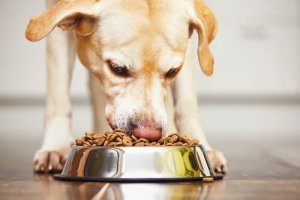Moisture Content in Dog Food: What Does It Mean?

You can find a wealth of information on food labels. However, understanding that information isn’t always easy, and it’s good to have basic knowledge to be able to interpret it. What about dog food? Well, the exact same thing applies. One of the most common questions asked is in regard to the moisture content of dog food.
Although it’s not obligatory according to Federal Law in the United States (some States may differ), leading dog food brands generally opt to include information on the label about the percentage of moisture the food contains.
It’s important to know what to look for on these labels, as well as choosing the right kind of dog food for your dog. You’ll want to make sure your pet is getting everything it needs in its diet.
What does the moisture content in dog food really mean?
The moisture percentage of food is a contributing factor to your pet’s health. However, a food that has a higher or lower moisture content doesn’t necessarily mean that it’s better or worse. Rather, it means that certain types of dog food will benefit different types of dogs depending on the state of their health, age, or calorie intake requirements.
Here’s a general guide to the different categories of dog food on the market. Watch out for the amount of moisture that should be present and the advantages of each type of food.
- Dry food: this is the kind of food that has less than 14% moisture. One advantage of dry dog food, or kibble, is that it’s very easy to store and keep for long periods of time. It also helps to keep your dog’s teeth clean. Your dog won’t get much plaque and tartar buildup if its diet is based mainly on this type of dog food.
- Semi-moist food: this should contain between 14% and 34% moisture. This is the least common dog food. However, it really provides the best of both worlds, since it ensures a balanced diet for your dog. It’s less likely than wet dog food to contribute to a tartar problem for your dog. This type of dog food is also very popular with dogs. It’s unlikely your pet will turn up its nose at semi-moist food.
- Wet dog food: this contains more than 34% moisture in its composition, and is the typical canned dog food that you’ll find in the supermarket. Once you open the tin, you should use it up within 3 days. The advantage of this type of dog food is that most dogs love it. It’s also easy to swallow since the dog barely even has to chew.

Moisture content in dog food: what kind of food should you choose?
As a general rule, dry kibble normally has around 10% moisture, while wet dog food can be around 80%. However, these percentages can vary depending on the manufacturer.
In any case, when choosing kibble for your pet, go for high quality. Dry dog food must pass rigorous testing and controls. It’s the most beneficial for dogs’ health.
Things to be aware of when choosing dog food
The three categories of dog food mentioned above are designed by specialists in canine nutrition. This means that they have all the nutrients your dog needs in order to have a balanced diet and to be strong and healthy.
However, there are some precautions that you should keep in mind when deciding what kind of food to feed your dog. Here are some of them.
For example, dog kibble won’t help to keep your dog hydrated. You’ll need to make sure your dog drinks plenty of water.
Besides this, although there’s generally a specific type of kibble for almost all dog breeds, some dogs just won’t like the kibble that’s best for their needs. If that happens, your dog may only just eat enough so that it’s not starving, but may become malnourished.
Another factor that you should consider is your dog’s teeth. Most dogs have a tendency to accumulate tartar. Dogs that consume a mainly wet food-based diet can be more prone to tartar buildup, along with its associated problems.

What you can do about your pet’s dental health
The use of dog dental sticks can be a good idea regardless of the type of food you give your dog. You’ll have even more reason to use them if your dog consumes mostly wet food. You’ll also help to avoid bad breath and will give your dog something to nibble on between meals.
What if you have any doubts or questions on the moisture content in the dog food you give your pet? Well, an appointment with the vet won’t be a bad idea. Your vet can help you choose the best type of food for your dog, as this can vary depending on your dog’s unique characteristics.
You can find a wealth of information on food labels. However, understanding that information isn’t always easy, and it’s good to have basic knowledge to be able to interpret it. What about dog food? Well, the exact same thing applies. One of the most common questions asked is in regard to the moisture content of dog food.
Although it’s not obligatory according to Federal Law in the United States (some States may differ), leading dog food brands generally opt to include information on the label about the percentage of moisture the food contains.
It’s important to know what to look for on these labels, as well as choosing the right kind of dog food for your dog. You’ll want to make sure your pet is getting everything it needs in its diet.
What does the moisture content in dog food really mean?
The moisture percentage of food is a contributing factor to your pet’s health. However, a food that has a higher or lower moisture content doesn’t necessarily mean that it’s better or worse. Rather, it means that certain types of dog food will benefit different types of dogs depending on the state of their health, age, or calorie intake requirements.
Here’s a general guide to the different categories of dog food on the market. Watch out for the amount of moisture that should be present and the advantages of each type of food.
- Dry food: this is the kind of food that has less than 14% moisture. One advantage of dry dog food, or kibble, is that it’s very easy to store and keep for long periods of time. It also helps to keep your dog’s teeth clean. Your dog won’t get much plaque and tartar buildup if its diet is based mainly on this type of dog food.
- Semi-moist food: this should contain between 14% and 34% moisture. This is the least common dog food. However, it really provides the best of both worlds, since it ensures a balanced diet for your dog. It’s less likely than wet dog food to contribute to a tartar problem for your dog. This type of dog food is also very popular with dogs. It’s unlikely your pet will turn up its nose at semi-moist food.
- Wet dog food: this contains more than 34% moisture in its composition, and is the typical canned dog food that you’ll find in the supermarket. Once you open the tin, you should use it up within 3 days. The advantage of this type of dog food is that most dogs love it. It’s also easy to swallow since the dog barely even has to chew.

Moisture content in dog food: what kind of food should you choose?
As a general rule, dry kibble normally has around 10% moisture, while wet dog food can be around 80%. However, these percentages can vary depending on the manufacturer.
In any case, when choosing kibble for your pet, go for high quality. Dry dog food must pass rigorous testing and controls. It’s the most beneficial for dogs’ health.
Things to be aware of when choosing dog food
The three categories of dog food mentioned above are designed by specialists in canine nutrition. This means that they have all the nutrients your dog needs in order to have a balanced diet and to be strong and healthy.
However, there are some precautions that you should keep in mind when deciding what kind of food to feed your dog. Here are some of them.
For example, dog kibble won’t help to keep your dog hydrated. You’ll need to make sure your dog drinks plenty of water.
Besides this, although there’s generally a specific type of kibble for almost all dog breeds, some dogs just won’t like the kibble that’s best for their needs. If that happens, your dog may only just eat enough so that it’s not starving, but may become malnourished.
Another factor that you should consider is your dog’s teeth. Most dogs have a tendency to accumulate tartar. Dogs that consume a mainly wet food-based diet can be more prone to tartar buildup, along with its associated problems.

What you can do about your pet’s dental health
The use of dog dental sticks can be a good idea regardless of the type of food you give your dog. You’ll have even more reason to use them if your dog consumes mostly wet food. You’ll also help to avoid bad breath and will give your dog something to nibble on between meals.
What if you have any doubts or questions on the moisture content in the dog food you give your pet? Well, an appointment with the vet won’t be a bad idea. Your vet can help you choose the best type of food for your dog, as this can vary depending on your dog’s unique characteristics.
All cited sources were thoroughly reviewed by our team to ensure their quality, reliability, currency, and validity. The bibliography of this article was considered reliable and of academic or scientific accuracy.
- Tienda animal. Beneficios de la comida húmeda para perros. Extraído de: https://www.tiendanimal.es/articulos/beneficios-de-la-comida-humeda-para-perros/
- Dingonatura. Las etiquetas de los alimentos. 2 de febrero de 2018. Extraído de: https://www.dingonatura.com/las-etiquetas-de-los-alimentos-n-30-es
- Lobo azul. Cómo leer las etiquetas de los piensos para perros. Extraído de: https://piensosloboazul.com/es/etiquetas-de-los-piensos-para-perros
This text is provided for informational purposes only and does not replace consultation with a professional. If in doubt, consult your specialist.








